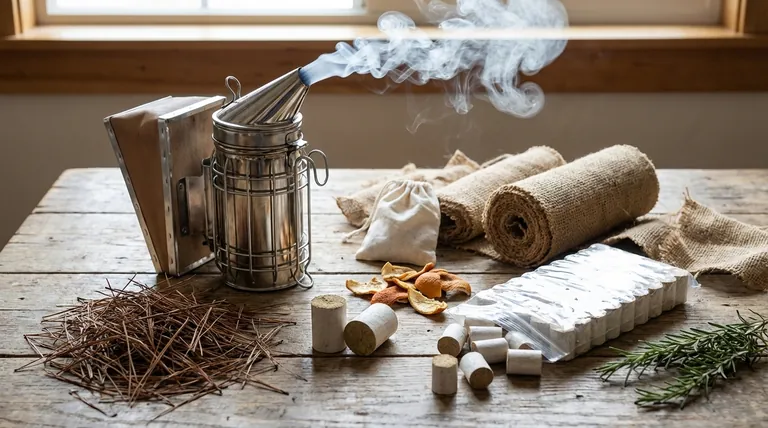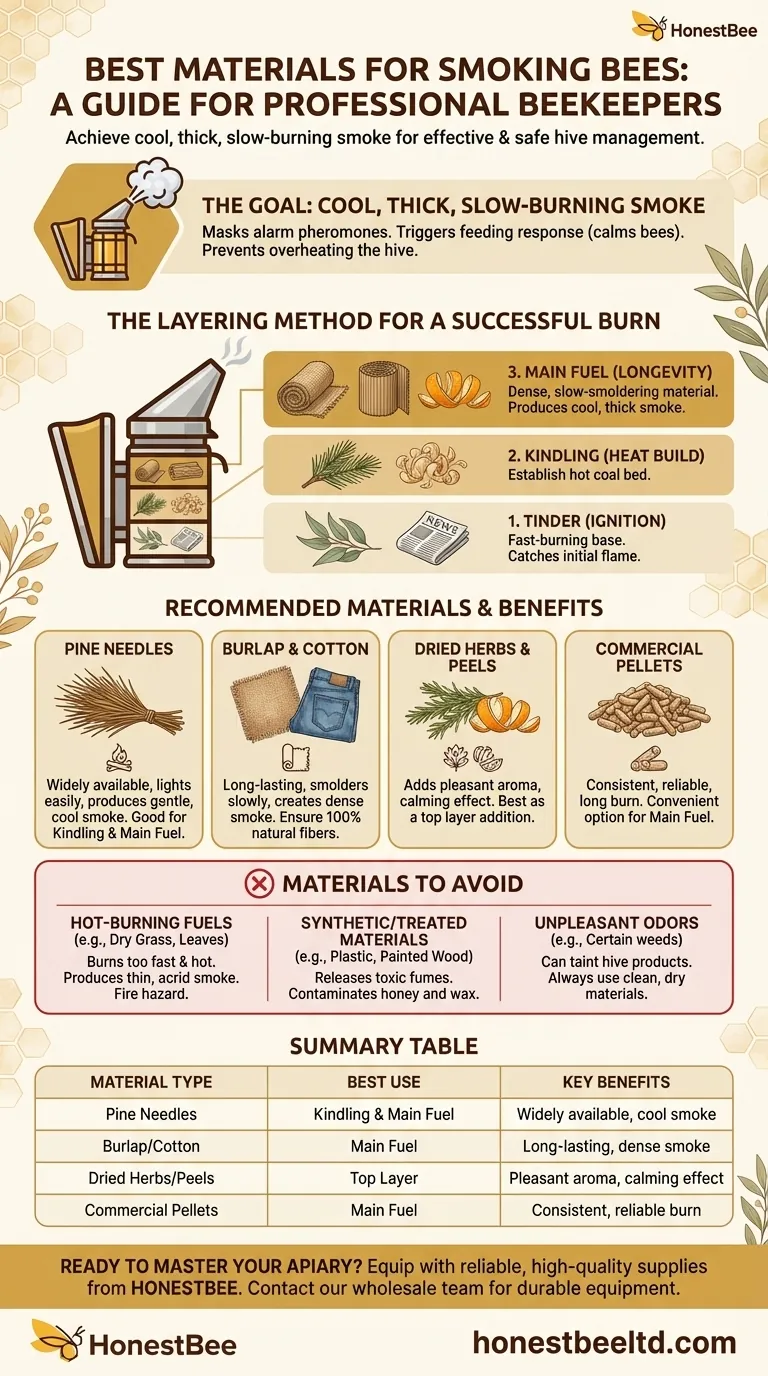The best materials for smoking bees are those that are natural, untreated, and burn slowly to produce a thick, cool smoke. Excellent options include dried pine needles, burlap from coffee sacks, untreated cotton scraps, dried citrus peels, and woody herbs like rosemary. These materials are effective because they smolder for a long time, calming the bees without harming them or tainting the honey.
The goal is not simply to create smoke, but to produce the right kind of smoke. Effective bee smoker fuel must burn cool and slow, producing a thick, white smoke that masks alarm pheromones without agitating the hive with excessive heat.

The Principles of Effective Smoker Fuel
To truly master your smoker, you must understand the properties of a good fuel source. The material itself is less important than how it burns.
Cool and Thick Smoke is Essential
The purpose of smoke is to interrupt the bees' primary chemical communication method: alarm pheromones. When a guard bee stings, it releases a pheromone that signals "attack" to the rest of the hive.
Thick, cool smoke masks this signal, preventing a colony-wide defensive response. It also triggers a feeding response in the bees, causing them to gorge on honey, which makes them more docile and less inclined to sting.
Dry and Natural Materials Only
Never burn anything synthetic, treated, or contaminated. Plastics, pressure-treated wood, and cardboard with glue or ink can release toxic fumes that will harm or kill your bees and contaminate your honey and wax. Stick to materials you would feel safe burning in your own home fireplace.
The Layering Method: Tinder, Kindling, and Fuel
A successful smoker is packed in three distinct layers to ensure it lights easily and burns for a long time.
1. Tinder (For Ignition): This is the base layer that catches the initial flame. It should be highly flammable but burn out quickly.
- Dried eucalyptus leaves
- A small piece of newspaper or a cardboard egg carton
- Cotton lint
2. Kindling (To Build Heat): This middle layer catches the flame from the tinder and establishes a hot coal bed.
- Dried pine needles
- Wood shavings (untreated)
- Small twigs
3. Main Fuel (For Longevity): This is the top and largest layer. It should be dense material that will smolder slowly, producing the desired cool, thick smoke.
- Burlap (from a clean coffee or potato sack)
- Rolled corrugated cardboard (with no wax or glue)
- Dried citrus peels, rosemary, or lavender for a pleasant scent
- Commercial smoker pellets made from cotton or compressed wood
Common Smoker Fuel Options
While many materials work, a few stand out for their reliability and availability.
Pine Needles
Dried pine needles are a favorite among beekeepers. They are widely available, light easily, and produce a gentle, cool smoke. They work well as both kindling and a main fuel source.
Burlap and Cotton
Scraps of natural burlap or old cotton fabric (like from a pair of jeans) are excellent. They smolder for a very long time and produce a fantastic, dense smoke. Ensure they are 100% natural fiber with no synthetic blends.
Dried Herbs and Peels
Materials like dried rosemary, citrus peels, or lavender can be added on top of your main fuel. While they burn more quickly, they produce a pleasant aroma that many beekeepers find helps in calming the bees.
Understanding the Trade-offs and Materials to Avoid
Choosing the wrong fuel can be worse than using no smoke at all.
Avoid Hot-Burning Fuels
Dry leaves or grass burn far too quickly and hot. This produces thin, acrid smoke that can anger the bees and even pose a fire hazard if sparks escape the smoker.
Never Use Synthetic or Treated Materials
This cannot be overstated. Burning plastic, polyester, nylon, painted or pressure-treated wood, or particleboard will release chemical compounds that are toxic to your bees and will make your honey unsafe for consumption.
Beware of Unpleasant Odors
Some materials, while technically safe, can produce an odor that is absorbed by the honey and wax. Always use clean, dry materials to ensure the purity of your hive products.
Choosing the Right Fuel for Your Needs
Your choice of fuel often depends on your goals and what is available to you.
- If your primary focus is convenience and reliability: Use commercial smoker pellets or clean burlap, as they provide the most consistent and long-lasting smoke.
- If your primary focus is cost-effectiveness and sustainability: Forage for natural materials like dried pine needles, wood shavings, and fallen leaves from your property.
- If your primary focus is a pleasant aroma and calm bees: Add a handful of dried rosemary, lavender, or citrus peels on top of your main fuel source.
Ultimately, mastering your smoker is about understanding the principles of a cool, slow burn, not just finding a single magic fuel.
Summary Table:
| Material Type | Best Use | Key Benefits |
|---|---|---|
| Pine Needles | Kindling & Main Fuel | Widely available, cool smoke |
| Burlap/Cotton | Main Fuel | Long-lasting, dense smoke |
| Dried Herbs/Peels | Top Layer | Pleasant aroma, calming effect |
| Commercial Pellets | Main Fuel | Consistent, reliable burn |
Ready to master your beekeeping? Equip your apiary with reliable, high-quality supplies from HONESTBEE. We supply commercial apiaries and distributors with the durable equipment needed for efficient, safe hive management. Contact our wholesale team today to discuss your needs and elevate your beekeeping operation.
Visual Guide

Related Products
- 54-Piece Smoker Fuel Pellets for Beekeeping Beehive Smoker Fuel
- Economy Galvanized Beekeeping Honey Bee Smoker for Wholesale
- Stainless Steel Honey Bee Smoker Hive and Honeycomb Smoker for Beekeeping
- Premium Traditional Copper Bee Smoker with Bellows
- Professional Bee Smoker with Elongated Spout and Durable Bellows for Beekeeping
People Also Ask
- What is the importance of fuel in a bee smoker? Ensure Cool, Calming Smoke for Your Hive
- What fuels are recommended for beehive smokers? Master the Art of Calm, Controlled Inspections
- What to put in a bee hive smoker? A Guide to Natural, Calming Fuels
- What is best to burn in a bee smoker? Master the Layered Fuel Technique for Calm Hives
- What are important considerations when choosing smoker fuel? A Guide to Safe, Effective Beekeeping



















